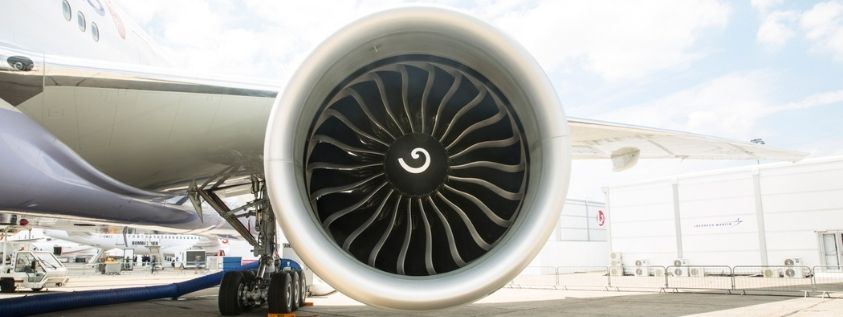Throughout the little more than one hundred years of aviation history, airplanes and their means of propulsion have evolved and adapted. From primitive internal combustion engines and propellers to today’s modern turboprops and turbojets, commercial aviation has gained in speed, service ceiling and efficiency.
In this installment we are not going to talk about all types of existing engines or their history, but we are going to dedicate the next few lines to describe the largest aircraft engines ever built. On the other hand, if you want to know the fuels of the aircraft of the future, we recommend you follow this link.
Ultrafan engine
The engine that tops the small ranking of the largest aircraft engines is neither more nor less than the largest engine in the world to date. It is an engine with an air intake diameter of 140 inches (more than three and a half meters), which is currently in the prototype phase. By the end of the year it will be ready to start the ground tests. In 2012 Rolls-Royce announced the beginning of the design of this engine, called Ultrafan, developing it over practically a decade to make it a reality.
To achieve the desired power, endurance and energy efficiency targets, this engine incorporates a newly architecture core that helps optimize fuel burn, while reducing polluting emissions and enabling a 25% fuel efficiency improvement. compared to the first generation of Trent engines from the same manufacturer.
To achieve its objectives, the UltraFan incorporates components with high resistance to ceramic matrix heat, and a gear system between the inlet and the high pressure turbine that will help maximize its efficiency. The blades, made of a carbon-titanium alloy, and the composite material shell help reduce weight by up to 680 kilograms per aircraft. Its entry into service is scheduled for the end of this decade.
GE9X engine
On the other hand, it is also vitally important to highlight the GE9X, from General Electric. The construction of this engine began in 2016. It has a 3.40 meter fan and it entered service since last year, implemented in the new version of the Triple 7, the B777X. The engine provides a thrust of 105,000 lbf (470 kN).
It should be noted that, although larger engines are usually associated with higher fuel consumption, their implementation in aircraft with high cargo or passenger capacity helps to reduce their polluting effect. Thus, for example, the average consumption of an A380 (Rolls-Royce Trent 900 or GE / Pratt & Whitney GP7200 engines) with a flat load is approximately 3 liters x 100 kilometers for each passenger transported.
JT9D engine
Although this engine is already smaller than the two previously mentioned, it is important to take it into account because its manufacturer, Pratt & Whitney, ranks third worldwide in the market for the manufacture of engines for the aeronautical industry.
This engine, also known as the “Jumbo jet” because it was recently fitted to the Boeing 747, is available in three versions. The first, with an intake diameter of 2.4 metres, has been designed to power aircraft such as the Boeing B767, Boeing B747 and Airbus A300; the second, with a diameter of 2.5 metres in its front section, has been developed for aircraft such as the Airbus A330 twinjet; and finally, the third version, with a diameter of 2.8 metres, has been designed to power the Boeing B777.
After this review of the largest aircraft engines in the world, it should be noted that, beyond their dimensions, the manufacture of these engines has been designed to work on reducing emissions and improving them for sustainability.
On the other hand, the current trend towards a reduction in the number of engines in large aircraft – after the retirement of the B747 and A340, the only four-engine currently in service is the Airbus A380 (Withdrawal of four-engine aircraft) – opens a panorama for the future composed of twin-engine aircraft with larger powertrains, but at the same time more reliable and more efficient in energy consumption, and with manufacturing processes that are more respectful with the environment. Quite a challenge from which, for the moment, it seems that Aviation is succeeding.
